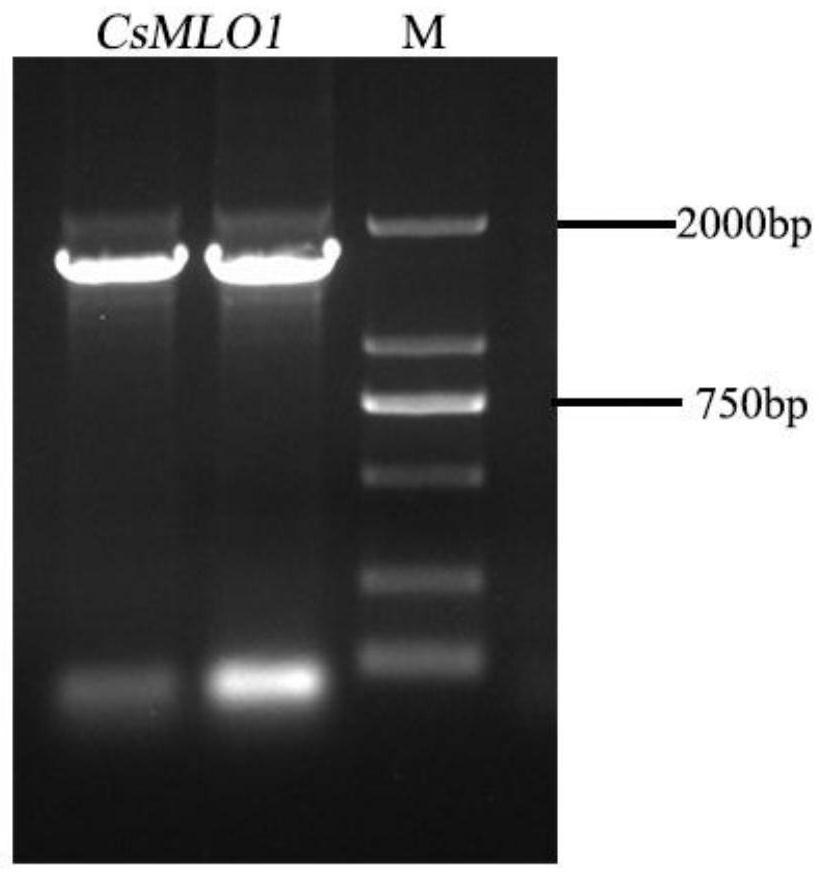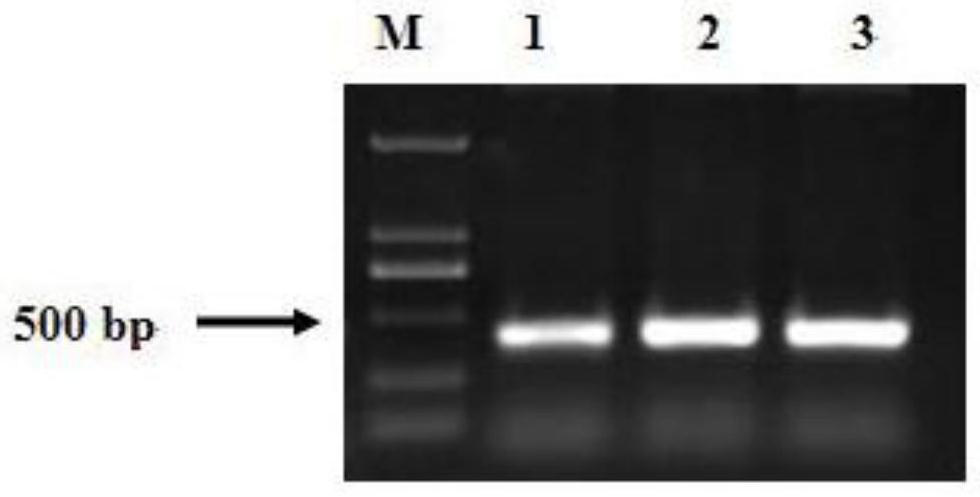Cucumber csmlo1 gene and its silent expression vector construction method and application
A cucumber and gene technology, applied in the field of molecular biology and biology, can solve the problems of little research on the interaction between cucumber and Corynesporium leaf spot, and achieve the effect of improving resistance and reducing the area of diseased spots
- Summary
- Abstract
- Description
- Claims
- Application Information
AI Technical Summary
Problems solved by technology
Method used
Image
Examples
Embodiment 1
[0034] Cloning of Cucumber CsMLO1 Gene
[0035] 1) The cDNA sequence of cucumber CsMLO1 gene is shown in SEQ ID NO.1. The amino acid sequence of the protein encoded by the CsMLO1 gene that regulates cucumber response to Corynesporium leaf spot is shown in SEQ ID NO.2.
[0036] 2) The cloning method of the cucumber CsMLO1 gene is as follows: use the cucumber leaves as the material, use the RNAprep pure plant total RNA extraction kit to extract the total RNA, reverse transcribe to synthesize cDNA, design primers to amplify the cucumber CsMLO1 gene, and the nucleotide sequence of the primers as follows:
[0037] CsMLO1-F: 5'-ATGGCGGGGGCAGCCGGTGG-3'
[0038] CsMLO1-R: 5'-TTCAACTCTATCAAATGAAA-3'.
[0039] Using the reverse-transcribed cDNA as a template, carry out polymerization chain PCR reaction, recover the PCR product, and obtain the 1749bp target fragment, refer to figure 1 . The purified product was sequenced to obtain the cucumber CsMLO1 gene whose sequence is shown in ...
Embodiment 2
[0041] Plant silencing expression vector construction
[0042]Referring to Figure 2(a), Figure 2(b) and Figure 2(c), the product pTRV2-CsMLO1 was recovered from the purified gel, and the pTRV2 vector with homologous sequences at the linearized end was used to clone CsMLO1 using the In-Fusion HD Cloning kit. The specific target fragment was ligated into the large linear fragment of pTRV2. The reaction system was: 2 μL 5×In-Fusion HD Enzyme Premix, 5 μL large linear fragment, 3 μL target fragment, and reacted at 50°C for 15 minutes. The ligation product was transferred to Escherichia coli competent DH5α, identified by colony PCR and sequencing, the bacteria were shaken, and the plasmid was extracted to obtain a plant silencing expression vector carrying the target gene pTRV2-CsMLO1.
Embodiment 3
[0044] Transient transformation of cucumber cotyledon for functional verification, refer to Figure 3(a) and Figure 3(b).
[0045] 1) Transformation of cucumber cotyledon with recombinant plasmid
[0046] Inoculate pTRV1 and Agrobacterium EHA105 positive clones containing the target gene pTRV2-CsMLO1 in liquid YEP medium (containing 50 μg mL -1 Rif and 50 μg mL -1 Kan), 28 ℃ 200rpm shaking culture for 48h, so that the Agrobacterium liquid culture to OD 600 0.6-1.0.
[0047] Transfer the bacterial solution into a sterile centrifuge tube and centrifuge at 5000rpm for 10min to collect the bacterial cells; use 10mmol·L -1 MES+10mmol·L -1 MgCl 2 +200μmol·L -1 Suspend the bacteria in the aqueous solution of As until the OD600 is 0.4, and place at room temperature for 3 hours; inject the bacteria suspension into the cotyledon of cucumber seedlings with a needle-free syringe of 9 days old.
[0048] The plant material is "Xintai Mici" cucumber;
[0049] 2) Identification of cucu...
PUM
 Login to View More
Login to View More Abstract
Description
Claims
Application Information
 Login to View More
Login to View More - R&D
- Intellectual Property
- Life Sciences
- Materials
- Tech Scout
- Unparalleled Data Quality
- Higher Quality Content
- 60% Fewer Hallucinations
Browse by: Latest US Patents, China's latest patents, Technical Efficacy Thesaurus, Application Domain, Technology Topic, Popular Technical Reports.
© 2025 PatSnap. All rights reserved.Legal|Privacy policy|Modern Slavery Act Transparency Statement|Sitemap|About US| Contact US: help@patsnap.com



